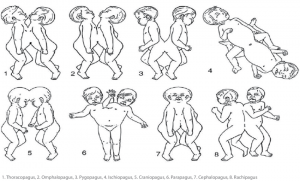What are Conjoined Twins?
Conjoined twins are twins that are born with physically connected bodies. Every case of conjoined twins is different, as they could be joined at different parts of the body. For instance, they could share only a small amount of tissue, and each pair could have their own set of organs and structures they need to essentially stay alive if they can be separated.
Others, the connection can become quite complex. The twins could share a vital organ, like the heart, or digestive, genital, and urinary systems. They could also share a huge portion of the body, like sharing the entire lower half of the body or be conjoined at the head where they share parts of the brain and skull.

Schematic diagram showing the various types of conjoined twins
A Case of a Successful Separation
Rital and Ritag Gaboura were joined at the head – and it took a team of more than 15 surgeons and doctors at Great Ormond Street Hospital in London to completely separate the conjoined twins.
The Gaboura twins turned out to be craniopagus twins – meaning they shared a skull but not a brain. This is extremely rare and occurs once out of every 2.5 million births.
Fortunately for them, if they shared the same brain, the surgery would have been too risky to even try.
The surgeons studied the twin’s skull and brain to meticulously strategize the network of delicate arteries and veins that transported blood to and from the brain. When separating the veins, if one twin ends up with too many veins, it would cause the heart to collapse. Leaving the other twin with not enough veins, the brain would swell up with blood.
To divide each vein, the surgeons opened a window in the twins’ skulls and operated on the veins in that little window. A craniotome, which is a high-speed drill was used to drill through the skull to reach the blood vessels, and essentially it would push the brain out of the way so only the bone would be cut.
The veins were sliced through and tied off with ligatures and dissolvable sutures. When it was possible, the shared veins were split at a junction so each twin could receive one part of the brain.
The final hurdle of full separation was that craniopagus twins do not have enough bone and skin between them to form a complete skull and scalp when it was time to sew everything up.
The problem was solved by putting four silicone balloons filled with the saline solution under the scalps, between the bone and skin. The balloons would progressively stretch the skin of the scalp.
- Inflatable balloons stretching the skin
The skull bone has three main layers: the tough outer layer, spongy middle layer, and tough inner layer. By driving chisels between each layer, the surgeons were able to split the bone and lift up a section so it would double the original area of the skull.
Rital and Ritag were able to recover after their separation, and the surgery has deemed a success as they were separated, and their organs were functioning independently.

The Gaboura Family

